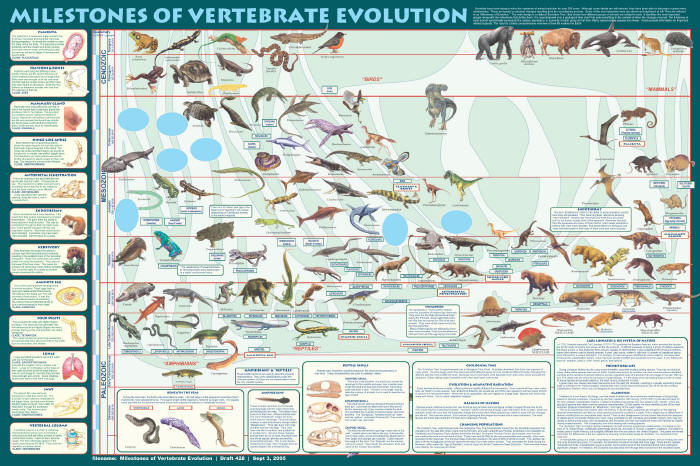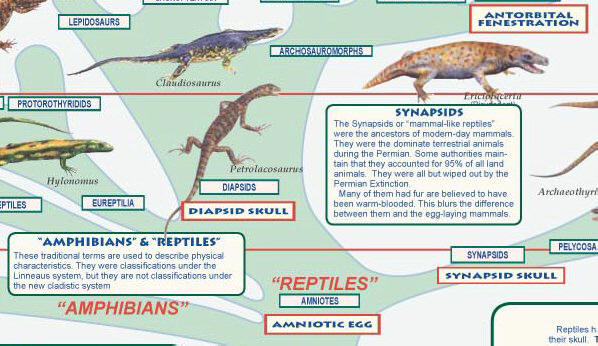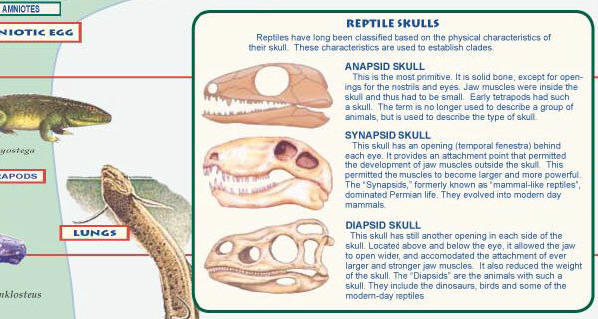|
|
|
Milestones of
Vertebrate Evolution |
|
The study of
prehistoric life is at the forefront of life science studies, natural
history museum interpretive programs, and popular culture, but there
has never been any comprehensive overview of the evolutionary steps in
any media. This remarkable poster fills that need. It
contains a wealth of information and presents it in a very simple way,
making it easy to understand. This title has been under
development for two years, but is finally coming together. If
you are interested in the evolution of our evolution poster,
click here. |
|
 |
|
Working Draft 428
|
|
About this poster |
In 1736, Swedish naturalist Carl
Linnaeus (1707-1778) published his Systema Naturae, which
provided the foundation for the study of what is now known as the life
sciences. Among other things, it introduced his classification system,
which has been greatly modified and expanded over the years. It
follows the sequence: kingdom, phylum, order, family, genus, and
species.
During Linnaeusí lifetime and for many years thereafter, scientists
studied existing species. They had no idea that earlier
species had lived on Earth. Fossils were known by primitive man and
were sometimes identified correctly as the remains of ancient life
forms, but the organized study of prehistoric life only began in the
late 18th century. The result was the newly-found science of
paleontology. It is the study of the developing history of life
on earth, of ancient plants and animals based on the fossil record,
preserved in rocks.
A great many new fossils have been discovered over the past few decades,
resulting in a greatly expanded knowledge of prehistoric life.
Paleontologists realized that many newly-discovered species did not
fit into the Linnaeus Classification System, which was not designed to
accommodate them.
Cladistics or "phylogenetic systematics,"
is a new branch of biology, one that seeks to determine the
evolutionary relationships of living things based on derived
similarities. Pioneered by German researcher Willi Hennig,
(1913-1976), it provides the basis for the new Cladistic
Classification System. |
 |
This exciting new
poster provides a comprehensive overview of vertebrate evolution
in accordance with the new cladistics system, which it introduces.
The most important evolved characteristics are shown and explained
as the "Milestones of Vertebrate Evolution."
These
provide the foundation for grouping similar animals together into
"clades," which have all but replaced the Linnaeus classifications.
|
|
|
The main design is an
"Evolution Tree," which is a stylized cladogram. It shows
and identifies all of the major clades. The "tree" design shows how
each branched off from earlier ones and other relationships. Each of
the milestones is predominately marked on the tree as they are the
basis for the most important clades.
|
|

|
|
The Evolution Tree is superimposed
over a geological time chart. The branches show how milestones
resulted in new groups of animals. The position of the branches
shows how animals are related. The beginning, end and length of
each branch shows when they lived, and, the thickness of branches
provides a symbolic representation of the relative abundance or scarcity of those animals
during each period of geological time.
|
|

|
Insets provide a wealth of additional information about related subjects. These include an introduction to
geological time, the dangers of unchecked evolution, the impact of
mass extinctions, adaptive radiation and how various types of animals
dominated the earth at various times. The evolution tree dramatically
shows the impact of the mass extinctions and the animals that radiated
as a result of them.
Best of all, when completed this poster will show around 130
different species positioned to show the results of evolutionary
milestones. Collectively they provide an incredible overview of
the diversity of prehistoric animals. The linage of each group can be
followed forward or backward in time.
The design makes it easy to see the mix of animals that
lived at various times.
Dr. Robert Reisz, vertebrate paleontology
at the University of Toronto is a pioneer in cladistics. His
classification system is
widely used and taught in North America. Dr. Reisz is working closely with
Feenixx Publishing to develop this cutting edge poster.
Virtually all life science professionals have accepted cladistics
and it is taught in most college level life science classes. However,
this new knowledge is just now beginning to seep into the grade schools.
This poster is written for middle school students and, to the
extent possible, avoids scientific terms. However its coverage
of the subject is so comprehensive that it will prove invaluable to both
college students and life science professionals.
This poster condenses a tremendous amount of information into a
simple but comprehensive presentation. Tests have shown that a reader with no
prior knowledge of the subject can gain an excellent basic
understanding of vertebrate evolution by just spending a few minutes reviewing
this poster. Teachers will find that it contains everything they
need to prepare a well-organized lesson plan.
As a footnote, our
Animal Kingdom poster shows all the phyla classified under the
old Linnaeus system. Milestones of Vertebrate Evolution can be
used with Animal Kingdom to compare the two systems. |
Current status:
The above layout utilizes stock art to provide guidelines for species
to be shown; their position, size and other things. As you can
see, not all species have been added, as the selection of each one
requires extensive research. Blue ovals indicate problem areas.
Once the species list has been finalized, it will require considerable
time to create the 150 highly-detailed illustrations. Once the
illustrations are complete and added to the poster, we have to fine
tune the size and position of everything. We anticipate that
this poster may not be complete until fall of 2006. Because of
the extensive content of this poster, we are considering producing it
twice the size of normal 24" x 36" poster. In other words, it
would be a huge 3 x 4 feet in size.
We are also considering using the research and images in
conventional size posters that present more specific subjects, such as
archosaurs, synapsids, prehistoric birds, etc. |
|
|
|
For the convenience of
our researchers and consultants, the above is available as a full size
JPEG.
Download Draft 426 Here |
|